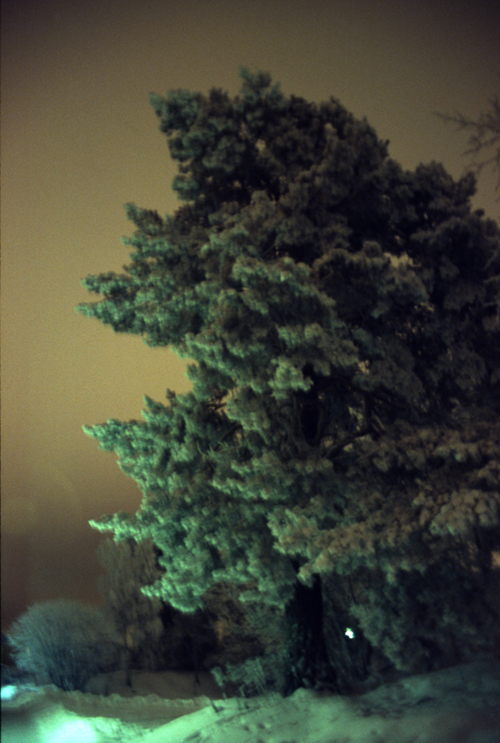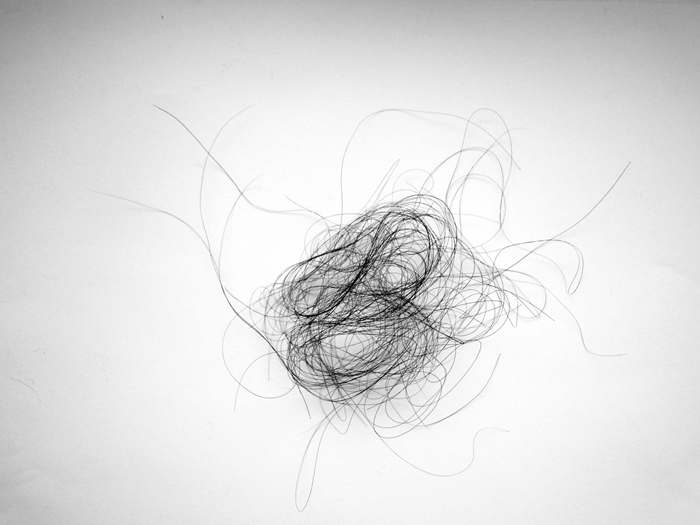塩﨑 由美子 SHIOZAKI Yumiko

《Una 2003》 シリーズ<Una>より 2006年 発⾊現像⽅式印画 135.0×90.0cm
Una 2003 from the series “Una” 2006 chromogenic print 135.0×90.0cm
塩﨑由美子
SHIOZAKI Yumiko
1954年、埼⽟県浦和市⽣まれ(現さいたま市浦和区)。さいたま市とスウェーデン、ストックホルム市在住、活動。
塩﨑由美子〈Una〉
笠原美智子
長野県立美術館館長(元東京都写真美術館事業企画課長)
塩﨑由美子の〈Una〉は穏やかな、美しい、ひとりの女性のポートレイトである。
塩﨑由美子の〈Una〉は、被写体を長い期間にわたって記録する伝統的なドキュメントの手法をとりながら、ドキュメンタリー写真とはまったく異なる作品を創り出した。そこに写るのは、ウナと塩﨑の対話やコミュニケーション、そして時間をかけた撮影そのものから生まれた信頼や親愛、葛藤などの生(なま)の関係性からこぼれ落ちた光景である。
塩﨑は1993 年にウナの娘の紹介で彼女に出会い、交流を重ねながら、2001 年から本格的にウナの撮影を開始した。ウナ・ゴールドは1916 年生まれ、2010 年にこの世を去った。ウナの最晩年、85歳から94歳まで、ストックホルムを拠点としている塩﨑は折に触れてロンドンのウナの自宅を訪ね、会話を重ね、撮影を続けた。第二次世界大戦を挟み、ウナ・ゴールドは長い間女優として活躍していた。死別した夫も独立した娘・息子も、共に俳優である。彼女は2004年に脳梗塞で倒れ、半年の入院生活の後に、半身不随となった。しかし車いすで住み込みヘルパーと共にロンドンの自宅で暮らし、その住み慣れたベッドで家族に見守られながら静かに息を引き取った。
塩﨑由美子の〈Una〉シリーズは、ウナが40年以上住み続けている家や庭の細部や、自宅でのウナの日常を写している。踝まで被さるような丈の長い白い部屋着を着て鬱蒼とした緑の庭に佇むウナ、穏やかな光を浴びながら窓辺でくつろぐウナの横顔、階段の壁に差し込む太陽の光や台所に吊された使い込まれたマグカップ、そして、彼女の死を経て子どもたちが冬の陽が差す広々とした公園にウナの遺灰を撒く姿、真っ青な空にわき上がる入道雲、小さな陶製の入れ物に大事にしまわれていた若き日の写真や手紙、遺品の数々…。
そもそもなぜ塩﨑は、住む場所も世代も人種も職業もまったく異なるこのひとりの女性にこれほどまでに惹きつけられたのか。塩﨑はストックホルムから、時には東京から、何千㎞の距離もものともせずに10年以上もウナに会いに通った。塩﨑は長年、異国で暮らし、病との闘いも強いられてきた。彼女は価値観も文化も人種も違う他者との関わりの中で、自分自身を客観的に捉え、主体化したアーティストとしてのアイデンティティを獲得していった。あまり耳も聞こえず身体も不自由でありながら、ひとりで穏やかに生き抜く、この意志の強い女性に寄り添うように撮影することに、塩﨑は彼女自身の「生」への光を見いだしたのだろう。〈Una〉の根底には、二人の女性の「精神の独立」がある。「精神の独立」とは、言うのは易しいが、歳を重ねるだけで自然と身に付くものではないことだけは確かである。混沌の20世紀を生き抜いた一人の英国人女性と、アジアから欧州にわたって自分の表現と格闘し続ける日本人女性の共振が、この美しいシリーズを生んでいる。
塩﨑由美子の〈Una〉が描くのは、生への希望といったものであるように思われる。
塩﨑由美子個展リーフレットより、La Maison de la Photographie, Lille, France, 2016年
SHIOZAKI Yumiko
Born in Urawa, Saitama in 1954. Lives and works in Saitama, Japan and in Stockholm, Sweden.
Yumiko Shiozaki 〈Una〉
Michiko Kasahara
Director, Nagano Prefectural Art Museum
Former Chief Curator, Tokyo Photographic Art Museum
Yumiko Shiozaki’s Una is a portrait of a calm and beautiful woman.
Using a traditional documentary method of following her subject over a long period of time, Yumiko Shiozaki’s〈Una) has produced something entirely different from conventional documentary photography. What you see is a form of on-going dialogue between Shiozaki and Una that involves trust, intimacy and even conflict. It is above all the outcome of frank and candid relationships that have emerged from a long shooting process.
Shiozaki met Una in 1993 when she was introduced by the subject’s daughter. It was from then on that their friendship grew. Around 2001, Shiozaki started to take photos of Una, working with ever increasing acuity and earnestness. Una Gold, who was born in 1916 and passed away in 2010, was often visited at her home by the Stockholm based Japanese artist Shiozaki in the last years of her life. Between the time Una was 85 years old and her death at the age of 94, a dialogue through images and words developed. Previously, Una’s calling was in the world of theatre and acting. Her career flourished both before and after the outbreak of World War II, and her late husband, as well as her daughter and son, all chose acting as their profession. Una suffered a stroke and was hospitalized for six months. Consequently, she became paralyzed on one side. However, by using a wheelchair and with the help of a live-in carer, she lived in her own home in London. It was there that she drew her last breath peacefully with her own family at her bedside.
Yumiko Shiozaki’s〈Una〉series depicts the details of Una’s house and garden. It looks at her daily life at home which had remained the same for some forty odd years. Wearing a long casual dress, which reaches down to her heal, Una nestles in the dense green of her garden. A profile of Una bathed by soft light shows her relaxing by the window. Sunlight illuminates a stair wall. Well-worn mugs decorate the kitchen. After her death, her children would scatter Una’s ash in the spacious park beneath the winter sunlight. White clouds tower over a bright blue sky. Photos and letters are a testament to youthful days gone by, and these mementos are preserved and cherished in a tiny porcelain container.
But why was Shiozaki attracted to a woman from a different place, race, culture and profession? What did the two individual women have in common? For over ten years, Shiozaki frequently flew from Stockholm, sometimes even travelling all the way from Tokyo. Shiozaki had lived in foreign counties and had been forced to fight illness herself. By interacting with somebody whose values, culture and race were distinct from her own, Shiozaki was able to observe herself objectively. It was part of her emerging identity as an independent artist. It was as if the intimacy between the two women and the very act of taking photos of this strong willed woman who lived in a calm and dignified fashion despite poor hearing and limited mobility, allowed the artist to discover the light of her own ‘life’. It is the “independent spirit’ of each of these two women that forms the foundation of〈Una〉. Gaining ‘Independent spirit’ sounds easy to say, but it is certainly something that doesn’t emerge exclusively through aging. Above all it resonates with the shared experience of an English woman who lived through the chaos of the twentieth century and that of a Japanese woman who came over to Europe from Japan and continued to wrestle with her own expression, it was all of this that brought about this beautiful series.
I feel that Yumiko Shiozaki’s〈Una〉conveys something which is akin to our vital hopes.
The Lieflet of Shiozaki Yumiko Solo Show at La Maison de la Photographie, Lille, France, 2016.
塩﨑由美子についての新しい情報は、作家のウェブサイト(現在調整中)、SNSをご覧ください。
Please refer to the following artist’s website(Now adjusting)/ social media pages for new updates.
https://yumikoshiozaki.jimdofree.com/
Instagram
facebook

《シリーズ<恢復>より》2011年、発⾊現像⽅式印画 120.0×80.0cm
from the series<recovery> 2011 chromogenic print 120.0×80.0cm

《シリーズ<kami>より》2011年 発⾊現像⽅式印画 29.7×42.0cm
from the series<kami> 2011 chromogenic print 29.7×42.0cm

《祈り》1996年 ホログラム、蝋燭、FRP 33.0×15.0×10.0cm
pray 1996 hologram,candle,FRP 33.0×15.0×10.0cm

《ディーバ_ユールスダーラ》2017年 ホログラム 21.0×26.0cm
diva_Djursdala 2017 hologram 21.0×26.0cm

《かの時》2021年 ガラス、LED 旧坂東家住宅⾒沼くらしっく館展⽰⾵景(さいたま国際芸術祭2020)
at that time 2021 glass, LED installation view at the Minuma classic house (Former Bando Family Residence), Saitama Triennale 2020

《マイセルフ》1979年 ファブリアーノ⽔彩紙 ロットリング ⽔彩⾊鉛筆 77.0×58.0cm
myself 1979 rotring, watercolor pencil on fabriano paper 77.0×58.0cm

